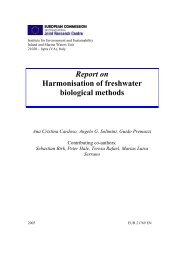Lakes and Watercourses
Lakes and Watercourses
Lakes and Watercourses
Create successful ePaper yourself
Turn your PDF publications into a flip-book with our unique Google optimized e-Paper software.
Assessment of current conditions<br />
TABLE 39.<br />
CURRENT CONDITIONS: bottom fauna index, watercourses<br />
(riffle areas)<br />
Class Description Shannon’s ASPT- Danish Acidity<br />
diversity index fauna- index<br />
index<br />
index<br />
1 Very high index > 3.71 > 6.9 7 > 10<br />
2 High index 2.97 – 3.71 6.1 – 6.9 6 6 – 10<br />
3 Moderately high index 2.22 – 2.97 5.3 – 6.1 5 4 – 6<br />
4 Low index 1.48 – 2.22 4.5 – 5.3 4 2 – 4<br />
5 Very low index ≤ 1.48 ≤ 4.5 ≤ 3 ≤ 2<br />
TABLE 40.<br />
CURRENT CONDITIONS: bottom fauna index, littoral zone of lakes<br />
(exposed shores)<br />
Class Description Shannon’s ASPT- Danish Acidity<br />
diversity index fauna- index<br />
index<br />
index<br />
1 Very high index > 3.00 > 6.4 > 5 > 8<br />
2 High index 2.33 – 3.00 5.8 – 6.4 5 6 – 8<br />
3 Moderately high index 1.65 – 2.33 5.2 – 5.8 4 3 – 6<br />
4 Low index 0.97 – 1.65 4.5 – 5.2 3 1 – 3<br />
5 Very low index ≤ 0.97 ≤ 4.5 ≤ 2 ≤ 1<br />
Apart from the acidity index, class boundaries are based on statistical<br />
breakdowns, where classes 1 <strong>and</strong> 5 are delimited by the 90th <strong>and</strong> 10th<br />
percentiles (O/C index 10th <strong>and</strong> 90th) <strong>and</strong> where the other class<br />
boundaries are divided evenly between the extremes. The class boundaries<br />
for the acidity index reflect the occurrence of various species along a<br />
pH gradient (see Appendix 2).<br />
67















![Accommodation booking form [PDF]](https://img.yumpu.com/39471785/1/184x260/accommodation-booking-form-pdf.jpg?quality=85)

